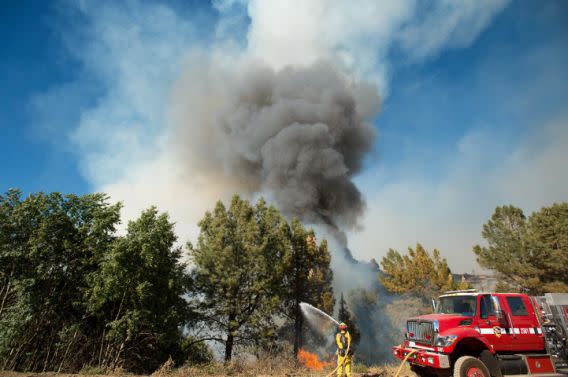NOAA: 2016 was second warmest on record in U.S.

The United States climate in 2016 was the second-warmest on record, according to a report released Monday by the National Oceanic and Atmospheric Administration (NOAA) — just behind 2012 in data that goes back 122 years.
There were also more than a dozen different climate disasters, which killed 138 people and caused an estimated $46 billion in damages.
According to NOAA, the average temperature in the lower 48 states for 2016 was 54.9 degrees Fahrenheit — 2.9 degrees warmer than the long-term average in the 20th century. It was the 20th straight year the annual average temperature surpassed that long-term average.
Scientists with NOAA’s National Centers for Environmental Information said that above-average temperatures were recorded in all of the 48 contiguous states and Alaska.
Brady Phillips, a climate service communicator for NOAA, said the agency is still crunching numbers on weather data received from climate organizations across the globe concerning last year’s world temperature, which may turn out to be the warmest on record. The National Aeronautics and Space Administration and NOAA are scheduled to unveil those findings in a joint press conference on Jan. 18.
During 2016, the United States suffered through 15 weather and climate disasters: one drought that affected several areas, one wildfire that affected several areas, four inland floods, eight severe storms and one hurricane.
That is the second highest number of catastrophes in the U.S. for a single year.
Disaster in 2016
Entire year: Drought in the West and East
Feb. 22-24: Tornadoes in the Southeast and East
March 8-12: Flooding in Texas and Louisiana
March 17-18: Severe weather in the South
March 23-24: Hailstorm in north Texas
April 10-12: Hailstorm in north and central Texas
April 17-18: Flooding in Houston
April 26-May 2: Tornadoes in the South and Southeast
May 8-11: Tornadoes in the Great Plains and severe weather in the central U.S.
May 21-26: Severe weather in the Rockies and the central U.S.
Summer-fall: Western and southern wildfires
June 22-24: Flooding and tornadoes in West Virginia
July 28-30: Severe weather in the Rockies and Northeast
Aug. 12-15: Flooding in Louisiana
Oct. 7-9: Hurricane Matthew in the Southeast
Zack Labe, who researches the effect of atmospheric and oceanic circulations on the climate system at the University of California, Irvine, said the graphics released by NOAA are not surprising.
“El Niño largely played a role in this year’s national (and global) warm temperature records. However, quantifying that contribution is challenging. The extent of the warmth is what is alarming and noteworthy in my opinion,” Labe told Yahoo News, referencing the above-average temperatures throughout the contiguous United States and Alaska.
“Alaska especially stands out — and this fits with what we are seeing in the Arctic,” he said. “While 2017 is very likely to be ‘cooler’ than 2016, we will continue to see the overall trend in the warming direction in the coming decade plus.”
Earlier this month, scientists at the University of Alabama in Huntsville’s Earth System Science Center (ESSC) announced that 2016 edged out 1998 as the warmest year on record globally in their 38 years of satellite record keeping.
According to ESSC, the report’s margin of error is roughly 0.10 Celsius so this would be a statistical tie, technically, but with a higher probability that last year was warmer than 1998.
“The question is, does 2016’s record warmth mean anything scientifically?” ESSC director and climate change skeptic John Christy said in a press release. “I suppose the answer is, not really. Both 1998 and 2016 are anomalies, outliers, and in both cases we have an easily identifiable cause for that anomaly: a powerful El Niño Pacific Ocean warming event.”
Read more from Yahoo News:


